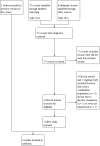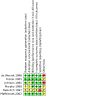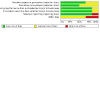Feverfew for preventing migraine
- PMID: 25892430
- PMCID: PMC7133498
- DOI: 10.1002/14651858.CD002286.pub3
Feverfew for preventing migraine
Abstract
Background: This review is an update of a previously published review in the Cochrane Database of Systematic Reviews on 'Feverfew for preventing migraine' (2004, Issue 1). Feverfew (Tanacetum parthenium L.) extract is a herbal remedy, which has been used for preventing attacks of migraine.
Objectives: To systematically review the evidence from double-blind randomised controlled trials (RCTs) assessing the clinical efficacy and safety of feverfew monopreparations versus placebo for preventing migraine.
Search methods: For this updated version of the review we searched CENTRAL, MEDLINE, EMBASE and AMED to January 2015. We contacted manufacturers of feverfew and checked the bibliographies of identified articles for further trials.
Selection criteria: We included randomised, placebo-controlled, double-blind trials assessing the efficacy of feverfew monopreparations for preventing migraine in patients of any age. We included trials using clinical outcome measures, while we excluded trials focusing exclusively on physiological parameters. There were no restrictions regarding the language of publication.
Data collection and analysis: We systematically extracted data on patients, interventions, methods, outcome measures, results and adverse events. We assessed risk of bias using the Cochrane 'Risk of bias' tool and evaluated methodological quality using the Oxford Quality Scale developed by Jadad and colleagues. Two review authors (BW and MHP for this update, MHP and EE for the original version) independently selected studies, assessed methodological quality and extracted data. We resolved disagreements concerning evaluation of individual trials through discussion.
Main results: We identified one new study for this update, resulting in six trials (561 patients) meeting the inclusion criteria. Five of the six trials reported on the main outcome, migraine frequency. Although five of the trials were generally of good methodological quality, all studies were either of unclear or high risk of bias with regards to sample size. Pooled analysis of the results was not possible due to the lack of common outcome measures and heterogeneity between studies in terms of participants, interventions and designs.The most recent trial added to this version of the review is rigorous and larger (n = 218), using a stable feverfew extract at a dose determined by a previous dose-finding trial. It reports that feverfew reduced migraine frequency by 1.9 attacks from 4.8 to 2.9 and placebo by 1.3 from to 4.8 to 3.5 per month, resulting in a difference in effect between feverfew and placebo of 0.6 attacks per month. For the secondary outcome measures intensity and duration of migraine attacks, incidence and severity of nausea and vomiting, and global assessment no statistically significant differences were reported. Results of previous trials are not convincing: three trials reporting positive effects of feverfew are all of small sample size (17 to 60 participants), while two rigorous trials (n = 50, 147) did not find significant differences between feverfew and placebo. Only mild and transient adverse events, most commonly gastrointestinal complaints and mouth ulcers, were reported in the included trials.
Authors' conclusions: Since the last version of this review, one larger rigorous study has been included, reporting a difference in effect between feverfew and placebo of 0.6 attacks per month. This adds some positive evidence to the mixed and inconclusive findings of the previous review. However, this constitutes low quality evidence, which needs to be confirmed in larger rigorous trials with stable feverfew extracts and clearly defined migraine populations before firm conclusions can be drawn. It appears from the data reviewed that feverfew is not associated with any major safety concerns.
Conflict of interest statement
B Wider: None known.
MH Pittler: None known.
E Ernst: None known.
Figures
Update of
References
References to studies included in this review
de Weerdt 1996 {published data only}
-
- Weerdt CJ, Bootsma HPR, Hendriks H. Herbal medicines in migraine prevention: randomized double-blind placebo-controlled crossover trial of a feverfew preparation. Phytomedicine 1996;3:225-30. - PubMed
Diener 2005 {published data only}
-
- Diener HC, Pfaffenrath V, Schnitker J, Friede M, Henneicke-von-Zepelin H-H. Efficacy and safety of 6.25 mg t.i.d. feverfew CO2-extract (MIG-99) in migraine prevention--a randomized, double-blind, multicentre, placebo-controlled study. Cephalalgia 2005;25:1031-41. - PubMed
Johnson 1985 {published data only}
Murphy 1988 {published data only}
-
- Murphy JJ, Heptinstall S, Mitchell JRA. Randomized double-blind placebo-controlled trial of feverfew in migraine prevention. Lancet 1988;2:189-92. - PubMed
Palevitch 1997 {published data only}
-
- Palevitch D, Earon G, Carasso R. Feverfew (Tanacetum parthenium) as a prophylactic treatment for migraine: a double-blind placebo-controlled study. Phytotherapy Research 1997;11:508-11.
Pfaffenrath 2002 {published data only}
-
- Pfaffenrath V, Diener HC, Fischer M, Friede M, Henneicke-von Zeppelin HH. The efficacy and safety of Tanacetum parthenium (feverfew) in migraine prophylaxis -- a double-blind, multicentre, randomized placebo-controlled dose-response study. Cephalalgia 2002;22:523-32. - PubMed
References to studies excluded from this review
Cady 2011 {published data only}
-
- Cady RK, Goldstein J, Nett R, Mitchell R, Beach ME, Browning R. A double-blind placebo-controlled pilot study of sublingual feverfew and ginger (LipiGesic™ M) in the treatment of migraine. Headache 2011;51:1078-86. - PubMed
Ferro 2012 {published data only}
-
- Ferro EC, Biagini AP, da Silva ÍE, Silva ML, Silva JR. The combined effect of acupuncture and Tanacetum parthenium on quality of life in women with headache: randomised study. Acupuncture in Medicine 2012;30:252-7. - PubMed
IRCT2014081218776N1 2015 {published data only (unpublished sought but not used)}
-
- Rafi S. Investigation of efficacy of feverfew and lavander in migraine prophylaxis. International Clinical Trials Registry Platform. http://www.irct.ir/searchresult.php?id=18776&number=1 , accessed 30 January 2015.
Karimooy 2011 {published data only}
-
- Karimooy HN, Gholamnezhad Z, Talebi M. Effect of tanacetum parthenium (feverfew) in treatment of migraine headache comparing to dihydroergotamine and placebo. In: Pain Medicine. Vol. 12. 2011:487.
Kuritzky 1994 {published data only}
-
- Kuritzky A, Elhacham Y, Yerushalmi Z, Hering R. Feverfew in the treatment of migraine: its effect on serotonin uptake and platelet activity. Neurology 1994;44 Suppl 2:A201.
Maizels 2004 {published data only}
-
- Maizels M, Blumenfeld A, Burchetter R. A combination of riboflavin, magnesium, and feverfew for migraine prophylaxis: a randomized trial. Headache 2004;44:885-90. - PubMed
Trader 2007 {published data only}
-
- Trader J-M. Feverfew as preventive therapy for migraine: N-of-1-trial for verification of individual efficacy. Zeitschrift fuer Allgemeinmedizin 2007;83:238-41.
Additional references
Anderson 1988
-
- Anderson D, Jenkinson PC, Dewdney RS, Blowers SD, Johnson ES, Kadam NP. Chromosomal aberrations and sister chromatid exchanges in lymphocytes and urine mutagenicity of migraine patients: a comparison of chronic feverfew users and matched non-users. Human Toxicology 1988;7:145-52. - PubMed
Awang 1998
-
- Awang DVC. Prescribing therapeutic feverfew (Tanacetum parthenium (L.) Schultz-Bip., syn. Chrysanthemum parthenium (L.) Bernh.). Integrative Medicine 1998;1:11-3.
Blau 1984
-
- Blau JN. Towards a definition of migraine headache. Lancet 1984;1:444-5. - PubMed
Brown 1997
-
- Brown AMG, Edwards CM, Davey MR, Power B, Lowe KC. Pharmacological activity of feverfew (Tanacetum parthenium (L.) Schultz-Bip.): assessment by inhibition of human polymorphonuclear leucocyte chemiluminescence in-vitro. Journal of Pharmacy and Pharmacology 1997;49:558-61. - PubMed
Brun 1995
-
- Brun J, Claustrat B, Saddier P, Chazor G. Nocturnal melatonin excretion is decreased in patients with migraine without aura attacks associated with menses. Cephalalgia 1995;15:136-9. - PubMed
Burry 1980
-
- Burry JN. Compositae dermatitis in South Australia: contact dermatitis from Chrysanthemum parthenium. Contact Dermatitis 1980;6:445. - PubMed
Dodick 2007
-
- Dodick DW, Silberstein SD. Migraine prevention. Practical Neurology 2007;7:383-93. - PubMed
Egger 1997
-
- Egger M, Zellweger-Zahner T, Schneider M, Junker C, Lengeler C, Antes G. Language bias in randomised controlled trials published in English and German. Lancet 1997;350:326-9. - PubMed
Ernst 2007
-
- Ernst E, Pittler MH, Wider B, Boddy K. Complementary Therapies for Pain Management. Edinburgh: Elsevier, 2007. - PubMed
ESCOP 2003
-
- ESCOP European Scientific Cooperative on Phytotherapy. Tanaceti parthenii herba, feverfew. In: ESCOP Monographs. 2nd edition. Stuttgart: Thieme, 2003.
Goadsby 1997
-
- Goadsby PJ. How do the currently used prophylactic agents work in migraine? Cephalalgia 1997;17:85-92. - PubMed
Hausen 1983
-
- Hausen BM, Osmundsen PE. Contact allergy to parthenolide in Tanacetum parthenium (L.) Schulz-Bip. (feverfew, Asteraceae) and cross-reactions to related sesqiterpene lactone containing Compositae species. Acta Dermato-Venereologica 1983;63:308-14. - PubMed
Hendriks 1996
-
- Hendriks H, Bos R, Woerdenbag HJ. The essential oil of Tanacetum parthenium (L.) Schultz-Bip. Flavour and Fragrance Journal 1996;11:367-71.
Heptinstall 1985
-
- Heptinstall S, White A, Williamson L, Mitchell JRA. Extracts of feverfew inhibit granule secretion in blood platelets and polymorphonuclear leucocytes. Lancet 1985;1(8437):1071-4. - PubMed
Heptinstall 1987
-
- Heptinstall S, Groenewegen WA, Spangenberg P, Loesche W. Extracts of feverfew may inhibit platelet behaviour via neutralization of sulphydryl groups. Journal of Pharmacy and Pharmacology 1987;39:459-65. - PubMed
Higgins 2003
IHS 1988
-
- Headache Classification Committee of the International Headache Society. Classification and diagnostic criteria for headache disorders, cranial neuralgias and facial pain. Cephalalgia 1988;8 Suppl 7:1-96. - PubMed
IHS 2000
-
- International Headache Society Clinical Trials Subcommittee. Guidelines for controlled trials of drugs in migraine,second edition. Cephalalgia 2000;20:765–86. - PubMed
IHS 2013
-
- Headache Classification Committee of the International Headache Society (IHS). The International Classification of Headache Disorders, 3rd edition (beta version). Cephalalgia 2013;33:629-808. - PubMed
Jadad 1996
-
- Jadad AR, Moore RA, Carrol D, Jenkinson C, Reynolds DJM, Gavaghan DJ, et al. Assessing the quality of reports of randomized clinical trials: is blinding necessary? Controlled Clinical Trials 1996;17:1-12. - PubMed
Knight 1995
-
- Knight DW. Feverfew: Chemistry and biological activity. Natural Product Reports 1995;12:271-6. - PubMed
Linde 2012
-
- Linde M, Gustavsson A, Stovner LJ, Steiner TJ, Barré J, Katsarava Z, et al. The cost of headache disorders in Europe: the Eurolight project. European Journal of Neurology 2012;19:703-11. - PubMed
Makheja 1982
-
- Makheja AN, Bailey JM. A platelet phospholipase inhibitor from the medicinal herb feverfew (Tanacetum parthenium). Prostaglandins Leukotrienes and Medicine 1982;8:653-60. - PubMed
Munakata 2009
-
- Munakata J, Hazard E, Serrano D, Klingman D, Rupnow MF, Tierce J, et al. Economic burden of transformed migraine: results from the American Migraine Prevalence and Prevention (AMPP) Study. Headache 2009;49:498-508. - PubMed
Murch 1997
-
- Murch SJ, Simmons CB, Saxena PK. Melatonin in feverfew and other medicinal plants. Lancet 1997;350:1598-9. - PubMed
Natural Standard 2014
-
- Natural Standard Research Collaboration. Feverfew. Natural Standard, available at www.naturalstandard.com (accessed 4 February 2014).
Nüesch 2010
Pareek 2011
Posadzki 2013
-
- Posadzki P, Watson LK, Alotaibi A, Ernst E. Prevalence of herbal medicine use by UK patients/consumers: a systematic review of surveys. Focus on Alternative and Complementary Therapies 2013;18:19-26.
Pugh 1988
-
- Pugh WJ, Sambo K. Prostaglandin synthetase inhibitors in feverfew. Journal of Pharmacy and Pharmacology 1988;40:743-5. - PubMed
Saranitzky 2009
-
- Saranitzky E, White CM, Baker EL, Baker WL, Coleman CI. Feverfew for migraine prophylaxis: a systematic review. Journal of Dietary Supplements 2009;6:91-103. - PubMed
Steiner 2013
-
- Steiner TJ, Stovner LJ, Birbeck GL. Migraine: the seventh disabler. Cephalalgia 2013;33:289-90. - PubMed
Sun‐Edelstein 2009
-
- Sun-Edelstein C, Mauskop A. Foods and supplements in the management of migraine headaches. Clinical Journal of Pain 2009;25:446-52. - PubMed
Taylor 2011
-
- Taylor FR. Nutraceuticals and headache: the biological basis. Headache 2011;51:484-501. - PubMed
Tfelt‐Hansen 1987
-
- Tfelt-Hansen P, Nielsen SL. Patient numbers needed in prophylactic migraine trials. Neuroepidemiology 1987;6:214-9. - PubMed
Tfelt‐Hansen 2012
-
- Tfelt-Hansen P, Pascual J, Ramadan N, Dahlöf C, D'Amico D, Diener HC, et al, International Headache Society Clinical Trials Subcommittee. Guidelines for controlled trials of drugs in migraine: third edition. A guide for investigators. Cephalalgia 2012;32:6-38. - PubMed
Vos 2012
Willigmann 1999
-
- Willigmann J, Freudenstein J. Production of a stable feverfew (Tanacetum parthenium) extract as an active substance for a pharmaceutical product. Internal document, Schaper Brummer GmbH and Co., 1999; Poster Symposium. Vienna: Society for Medicinal Plant Research; 1998.
World Health Organization 2012
-
- World Health Organization. Headache disorders. Fact sheet N°277. http://www.who.int/mediacentre/factsheets/fs277/en/ 2012 (accessed 29 January 2014).
References to other published versions of this review
Ernst 2000
-
- Ernst E, Pittler MH. The efficacy and safety of feverfew (Tanacetum parthenium L.): an update of a systematic review. Public Health Nutrition 2000;3:509-14. - PubMed
Pittler 2000
Pittler 2004
Vogler 1998
-
- Vogler BK, Pittler MH, Ernst E. Feverfew as a preventive treatment for migraine: a systematic review. Cephalalgia 1998;18:704-8. - PubMed
LinkOut - more resources
Full Text Sources
Other Literature Sources




